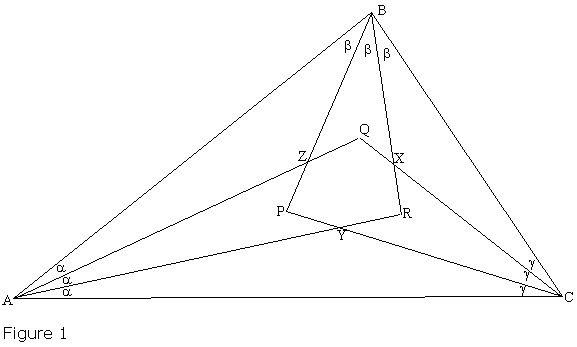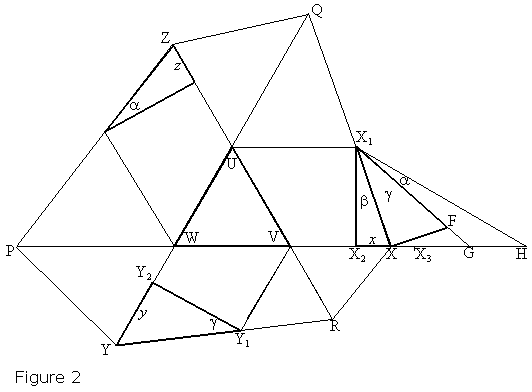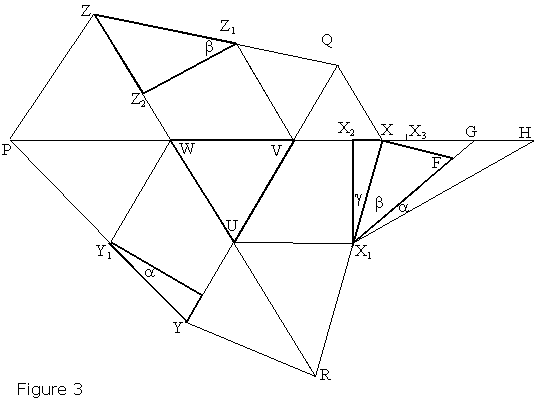Morley's Theorem, a Proof
Brian Stonebridge (University of Bristol, UK)
Bill Millar
In Figure 1, the near trisectors of the internal angles at the vertices A, B, and C of a triangle meet in X, Y, and Z. Morley's theorem states that the triangle XYZ is equilateral. We give here a direct Euclidean proof.

Let the far trisectors meet in P, Q, and R. The following proof that PX, QY, and RZ are concurrent is purely Euclidean; a stronger result can be proved using projective geometry. Figure 1 shows the angle values α, β, γ, implying α + β + γ = π/3, and ∠QXR = π - β - γ. Since Y is the incentre of ΔAQC, it follows that
Assume PX, QY and RZ meet in pairs at U, V, and W. By transitivity, either U, V, W all coincide or are all distinct. We show that the assumption that the three points are distinct leads to a contradiction. Indeed, this might happen in two ways, as illustrated in Figures 2 and 3 (below.) We focus on the diagram of Figure 2, the other one being entirely analogous. Sum the angles of quadrilateral QURX, using the above results, to find
| (1) | d ≠ 0. |
Choose X1 on QX such that UX1 is parallel to PX. Then the angles ZUQ, QUX1, X1UV all are π/3. Now choose X2 and X3 on PX such that

Denote X2X by x, then
| (2) | VX = UZ - d + x. |
Similarly, defining y and z in the same way as for x,
| (3) | WY = VX - d + y, |
| (4) | UZ = WY - d + z. |
Adding equations (2)-(4) gives
| (5) | x + y + z = 3d. |
Now extend the line PX to H, such that ∠X2X1H = π/3, and hence
| X2H | = X1X2 × √3 | |
| = (d × √3) × √3 | ||
| = 3d. |
Choose G on X2H such that
Now complete the proof of Morley's Theorem. As was observed earlier, in Figure 2,

Morley's Miracle
On Morley and his theorem
- Doodling and Miracles
- Morley's Pursuit of Incidence
- Lines, Circles and Beyond
- On Motivation and Understanding
- Of Looking and Seeing
Backward proofs
- J.Conway's proof
- D. J. Newman's proof
- B. Bollobás' proof
- G. Zsolt Kiss' proof
- Backward Proof by B. Stonebridge
- Morley's Equilaterals, Spiridon A. Kuruklis' proof
- J. Arioni's Proof of Morley's Theorem
Trigonometric proofs
- Bankoff's proof
- B. Bollobás' trigonometric proof
- Proof by R. J. Webster
- A Vector-based Proof of Morley's Trisector Theorem
- L. Giugiuc's Proof of Morley's Theorem
- Dijkstra's Proof of Morley's Theorem
Synthetic proofs
- Another proof
- Nikos Dergiades' proof
- M. T. Naraniengar's proof
- An Unexpected Variant
- Proof by B. Stonebridge and B. Millar
- Proof by B. Stonebridge
- Proof by Roger Smyth
- Proof by H. D. Grossman
- Proof by H. Shutrick
- Original Taylor and Marr's Proof of Morley's Theorem
- Taylor and Marr's Proof - R. A. Johnson's Version
- Morley's Theorem: Second Proof by Roger Smyth
- Proof by A. Robson
Algebraic proofs
Invalid proofs
|Contact| |Front page| |Contents| |Geometry|
Copyright © 1996-2018 Alexander Bogomolny
73549813
